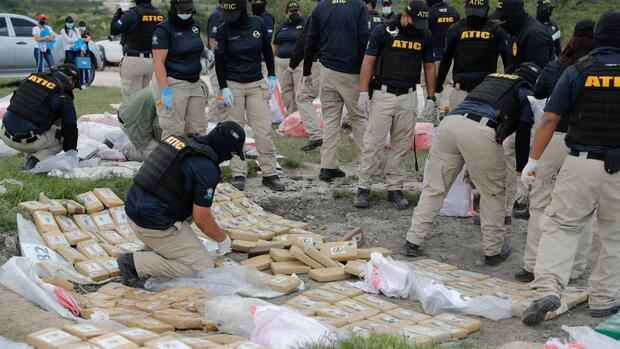The cartels make most of their money from drugs. The profits made are laundered into billions.
(Photo: imago images/Agencia EFE)
Mexico City, Frankfurt Organized crime in Latin America is using ever more sophisticated methods to cover up their money flows – and in the meantime has also discovered cyberspace. This is according to a report by the International Narcotics Control Board (INCB), which monitors compliance with the United Nations (UN) international drug control treaties.
According to the authors, Mexican cartels in particular are increasingly using cryptocurrencies to launder their proceeds from dirty deals such as drug trafficking, kidnappings or extortion. In total, the drug cartels in Mexico alone are said to launder around 25 billion dollars a year, which corresponds to around 2.6 percent of the gross domestic product of Latin America’s second largest economy.
Exactly how large the share that can be attributed to cryptocurrencies is open. Preferred instruments for money laundering are still banks, cash couriers or so-called hawala banking. Hawala banking is a kind of coded transfer system that does not work with cash, but with calculations that are more difficult to understand. At the same time, however, “both Mexican and Colombian organized crime groups” would increase their “use of digital currencies”. The authors cite “anonymity and speed of transactions” as the reason.
>> Read here: Lagarde warns crypto firms against aiding and abetting sanctions evasion
Top jobs of the day
Find the best jobs now and
be notified by email.
In this context, representatives of the crypto industry repeatedly point out that transactions with the common crypto currencies are by no means anonymous, but only “pseudonymous”. Because transactions with well-known cryptocurrencies such as Bitcoin or Ether are documented in the so-called blockchain, are unchangeable and can be viewed publicly at any time.
The addresses, comparable to account numbers, must be clearly assigned to the customer on regulated crypto exchanges. Criminals who used cryptocurrencies for illegal activities in the past are being convicted more and more frequently.
Ex-investigator: “Money laundering using cryptocurrencies is definitely practiced”
According to Michael Peters, a former investigator at the Federal Criminal Police Office and now an expert on money laundering at the consulting firm Ankura, money laundering using cryptocurrencies is “possible – and is definitely practiced”. The only question is to what extent.
Peters, who is also a member of the board of the Federal Association for the Prevention of Money Laundering, emphasizes that crypto service providers in Germany are “comparatively well regulated” by the Money Laundering Act, among other things. Globally, however, things look different. The possibilities for this are “restricted by the regulation that has now been introduced, but still cannot be ruled out”.
According to a recent UN report, Latin American cartels are increasingly relying on cryptocurrencies
(Photo: Reuters)
“So-called mixers and tumblers in particular are a thorn in the side of the investigators,” he adds, while the origin of crypto funds is deliberately concealed. In addition to Bitcoin and Ether, there are also many so-called privacy coins, in which transactions are much more difficult to trace. In a recent report, the United Nations Office on Drugs and Crime (UNODC) emphasizes that payment for drugs sold online is likely to shift from traceable cryptocurrencies to privacy coins in the future.
In Mexico, the “Sinaloa Cartel” and the “Jalisco New Generation Cartel” (CJNG), the two “leaders” of Mexico’s illegal economy, are increasingly using cyberspace. But Colombian groups, militias in Rio de Janeiro and kidnapping gangs in Venezuela and Argentina are also increasingly using virtual currencies, crime experts emphasize.
Transactions are obfuscated through smurfing
The cartels’ financial jugglers use what is known as “smurfing”: They divide illegal proceeds into small amounts, pay them into several bank accounts and then buy small sums of Bitcoin using sometimes false identities or digital straw men. In order to circumvent the alarm systems of international banks, tens of thousands of small and micro amounts are transferred and purchases are made, which are always below $7,500, the report shows.
According to Insight Crime, a US news portal specializing in organized crime in Latin America, the cartels hire so-called ciberburros (e.g. cyber donkeys) to do this. With the identities of mostly young people, large amounts of digital currencies are purchased via apparently many different buyers and then used to pay business partners all over the world.
>> Read here: A year ago Corona hell, now vaccination world champion: How South America managed the turnaround
Last year, Mexico’s financial regulator UIF uncovered 12 cryptocurrency exchanges operating without legal licenses. At the time, UIF boss Santiago Nieto expressed the suspicion that the trading centers were connected to criminal organizations, including CJNG.
To track the use of cryptocurrencies, Mexico’s government enacted a law in 2018 requiring registered trading platforms to report transfers of more than 56,000 Mexican pesos ($2,682). In September, the Treasury Department froze the bank accounts of 186 people linked to five cartels. The United Nations criticizes that all of these steps have not slowed down the increasing trade in cryptocurrencies in Mexico.
According to the report, however, “analogue” forms are still the preferred tool for large-scale money laundering in Mexico. As an example, the Mexican branch of the British bank HSBC, which admitted ten years ago to have laundered 881 million dollars for the “Sinaloa cartel”. At the time, the bank got away with a fine of $1.9 billion. According to investigators’ findings, Mexico’s financial institutions continue to launder money for cartels to this day.
How much money they generate is difficult to quantify. According to the US think tank “Global Financial Integrity”, the drug trade in North and South America alone generates between 80 and 90 billion dollars a year. Overall, however, the use of cyber currencies by organized crime is still in the early stages, suspects Falko Ernst, Mexico analyst at the non-governmental organization International Crisis Group.
More: Overturning sanctions: Why the EU isn’t cracking down on cryptocurrencies
